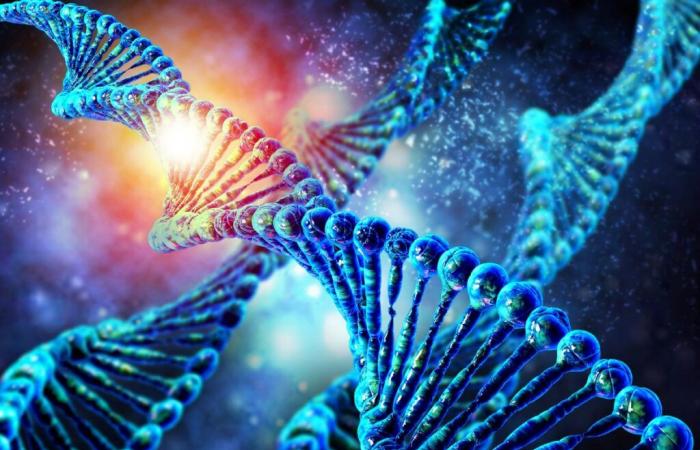On December 12, the CNRS will present its gold medal to one of the world’s specialists in epigenetics, Edith Heard. Lise Barnéoud, author from a work entitled The truant cells published by Premier Parallèle [1]takes this opportunity to take stock of this fascinating discipline, which questions the role of the environment and our lifestyles on gene expression. This article was originally published in the section Shards of Science from Mediapart.
You haven’t heard the last thing about epigenetics. Firstly because Edith Heard will receive the CNRS gold medal on December 12 for her “ exceptional contributions to the advancement of this discipline “. But also, because not a single month goes by without a new publication shaking up our knowledge of the multiple processes that influence the activity of our genes, without ever touching their DNA sequence.
In your biology memories, you may have remembered this equation: a gene = a protein = a consequence. This actually works for some characteristics, notably for rare so-called monogenic diseases such as Huntington’s chorea or cystic fibrosis. But otherwise, things are always more complex. Firstly because the visible consequences (we speak of phenotypes), such as eye color, are linked not to a single gene but to several. Then, because epigenetic mechanisms, literally above genetics, put their grain of salt into it.
“A book full of post-its”
After having sequenced the genomes of countless species and individuals, we quickly had to face the facts: organisms are not, far from it, the result of a “genetic program” written in their DNA. Moreover, scientists have gradually abandoned this “program” metaphor. Now, they often use another image to explain the role of epigenetics: that of a book stuffed with post-its. These little adhesive notes, stuck on certain pages, offer another level of information, emphasizing certain passages and neglecting others.
This is a bit like how epigenetic marks work. Small molecules are in fact positioned on the immense DNA threads which constitute the chromosomes, therefore modifying their reading. If we imagine that these strands of DNA form the sentences of a book, then we must visualize completely crumpled pages. And for good reason: in the human species, if we put our 46 chromosomes end to end, this represents a DNA thread approximately two meters long. However, this wire is contained in a core with a radius of less than 10 micrometers!
« It’s like putting a very fine 8 kilometer wire inside a ping-pong ball. », illustrates the geneticist Corinne Augé, who has just written a book on epigenetics[2]. Result: portions of DNA sometimes find themselves so compacted that they become inaccessible to reading. Epigenetic marks make it possible to smooth them out or, on the contrary, to wrinkle them even more. They constitute what researchers call the epigenome.
The role of the environment
Note that there are other epigenetic mechanisms capable of modifying the reading of our genes without affecting the DNA sequence. For example, the Nobel Prize in Medicine was given this year to Victor Ambros and Gary Ruvkun, two American researchers who work on micro-RNAs, molecules which intervene after the reading of genes by modulating protein synthesis.
To give an idea of the central role of epigenetic mechanisms, think of a skin cell versus a neuron for example. These two cells have the exact same DNA book, yet they are very different. “ Each of our 215 categories of cells has its own epigenetic marks, and this is what defines its identity », explains Corinne Augé.
These marks are placed very quickly in our DNA book, during our embryonic development. And their apposition depends on the position of the cells within the embryo, specifies the researcher from the University of Tours. We could call them obligatory, innate post-it notes.
But subsequently, other post-its may be added or, on the contrary, erased. We then speak of epimutations. And it is the environment that will influence these new brands. The environment at the cellular scale, at the scale of an organ as well as at the scale of an entire organism. For example, cigarette smoke modifies the epigenome, particularly in lung cells.
Consequences often difficult to understand
On the scale of the entire organism, a striking example is that of bees: during their larval development, the epigenetic marks will be very different if they receive exclusively royal jelly or not. In the first case, they become queens, in the second case, workers. With exactly the same DNA.
From there to imagining that we too could transform ourselves into queens with a specific diet, there is a huge step… which some nevertheless take. “Epigenetic cures” or nutri-epigenetic supplements are starting to flourish, to help us “express the best of our DNA”.
« It makes me jump when I hear that a specific diet can sculpt our epigenomecritic Corinne Augé. In adulthood, we have no proof that diet can modify our epigenomes, nor that these possible modifications can subsequently improve our well-being.. » Herein lies one of the major limitations of studies on epigenetics: very few manage to link an epimutation to a consequence. Moreover, many of these modifications seem silent, others disappear quickly.
And even when we see phenotype-specific epimutations, like obesity, those can also be a response to disease. For example, a diet rich in fat will modify the metabolism of cells, which will subsequently act on epigenetic marks. The causal relationship is reversed here: it is the onset of the disease that will change the epigenome.
On the other hand, what is not called into question is the influence of maternal diet and environment during pregnancy on the epigenetic marks of the unborn baby. Like bees after all. Because during larval development, just as during our intrauterine development, cells – particularly brain cells – are particularly sensitive to environmental variations.
Epimutations and family history
One of the studies most often cited to illustrate the impact of the mother’s diet on the epigenome of her child is the “Dutch cohort”, also nicknamed “the hunger cohort”. This study brings together 821 people born in Amsterdam between January 7 and December 8, 1945, who suffered in utero from severe famine linked to the occupation of the Netherlands by Nazi Germany. These individuals are compared to nearly 1,600 people born just before or just after the famine in the same families.
Researchers first observed that people whose mothers suffered from starvation during pregnancy present more frequently than others with metabolic disorders, cardiovascular diseases or even mental disorders such as schizophrenia.
Then, by comparing the epigenome of the blood cells of these individuals exposed in utero to famine with that of the control group, these same researchers discovered specific epimutations, particularly around genes involved in metabolism. “ Our data are consistent with the hypothesis that epigenetic factors mediate between an adverse prenatal environment and long-term metabolic health. », conclude the authors, while recognizing that the cause and effect link still remains to be elucidated.
A potential long-term effect
« The fact that we detect seventy years later an epigenetic signature which appears to be specific to in utero exposure to famine shows that these marks persist and can therefore have a long-term effect. », comments Patrick Allard, a French researcher who set up his own laboratory entitled “Environmental Memory” at the University of California, in the United States.
What about the next generation? Can these epimutations be transmitted to offspring, not exposed to famine? This is the big question, which still divides specialists. To try to answer this, the children of individuals exposed in utero to this famine were compared to control groups and all sorts of conclusions emerged. Thus, the offspring of women exposed in utero were heavier at birth, while those whose fathers were exposed in utero were heavier as adults.
Could these specificities be explained by epigenetic marks transmitted by parents? Theoretically, most of these epimutations are supposed to disappear during two key moments: just after fertilization and at the time of gamete production. As a double security so that all the post-its are removed from the book before giving it to the next generation.
Brands passed on to subsequent generations?
« In reality, we are not making a clean slate, certain brands remain », underlines Patrick Allard, who is notably carrying out studies on the C. elegans worm – a laboratory animal model – demonstrating the persistence of modifications over more than five generations. “ This transgenerational persistence has also been observed in plants, yeasts, zebra fish, fruit flies… I don’t see why we would be different from the rest of life on this point. », notes the researcher, who regrets a certain form of resistance within the scientific community towards this hypothesis.
Edith Heard, who is rather one of the sceptics, recognized this year that “proof of principle” of a transgenerational transmission of epimutations in mammals had been provided in 2023 by a study on mice. However, these were modifications induced artificially, via epigenetic manipulations. Which could bias the results. Furthermore, ” scientists tried other epimutations which did not persist », says Patrick Allard. Which suggests a rare phenomenon rather than a biological norm.
Let us admit, however, that this transgenerational transmission is possible in humans. “ In this case, we escape one evil only to fall into another », analyzes Michel Morange, historian and philosopher of biology. In fact, epigenetics should free us from biological fatalism, remove us from our original genetic condition. But if certain epimutations ultimately prove stable and transmissible, another form of determinism would emerge, linked to the exposures and lifestyles of our ancestors. “ Parents could feel guilty if their child is ill because of their behavior or their diet! », underlines the French researcher. In short, what was supposed to “free us from our genes” could therefore turn out to be even more guilt-inducing…
We are certainly more than our genes since a multitude of post-its modulate their reading. However, epigenetics cannot be summed up in a new simplistic equation such as: an environment = an epimutation = a consequence. No offense to those who hoped to find a liberating revolution in this discipline.
[1] Lise Barnéoud also offered a Tedx Talk on the theme of microchimerism: Tricky cells, how microchimerism is reshaping our lives
[2] Epigenetics and the giraffe’s neck, published by HumenSciences
Editor’s note: The article by Lise Barnéoud is reproduced here with the author’s consent.
Photo : iStock






